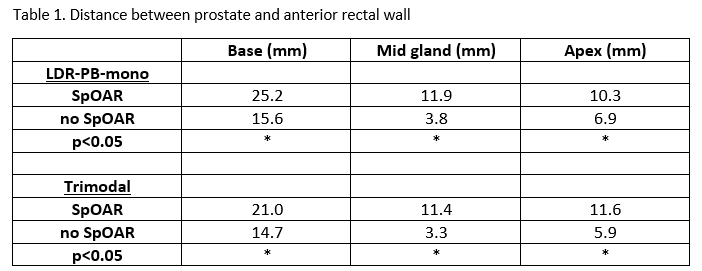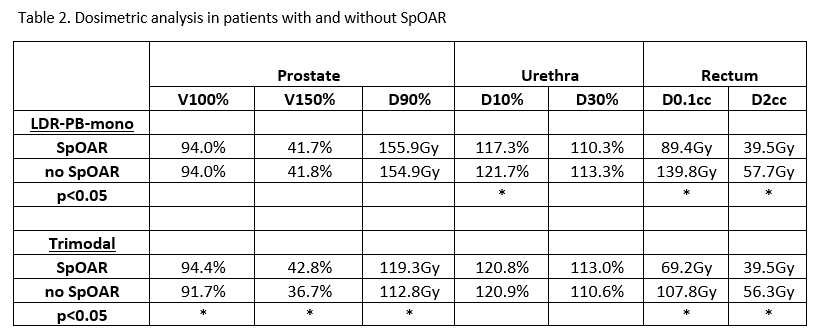Rectal spacing hydrogel - significant improvements in LDR prostate brachytherapy dosimetry
Sheel Mehta,
United Kingdom
PO-1352
Abstract
Rectal spacing hydrogel - significant improvements in LDR prostate brachytherapy dosimetry
Authors: Sheel Mehta1, Sara Khaksar1, Carla Perna1, Sophie Otter1, Christos Mikropolous1, Mel Cunningham2, Santiago Uribe-Lewis3, Jennifer Uribe3, Stephen Langley3
1Royal Surrey County Hospital, Oncology, Guildford, United Kingdom; 2Royal Surrey County Hospital, Medical Physics, Guildford, United Kingdom; 3Royal Surrey County Hospital, Urology, Guildford, United Kingdom
Show Affiliations
Hide Affiliations
Purpose or Objective
Low dose rate prostate brachytherapy (LDR-PB) is an effective treatment in patients with prostate cancer. Used as monotherapy in low to intermediate risk patients, or in combination with androgen deprivation therapy (ADT) and external beam radiotherapy in patients with more advanced disease (trimodal). Adverse rectal dosimetry causing early and late rectal toxicity can significantly impact patients’ quality of life. The purpose of this study is to evaluate the impact of rectal spacing hydrogels in improving dosimetry of LDR-PB with a direct comparator arm, of which there are currently limited data.
Material and Methods
Data from patients treated with I125 LDR-PB were identified from our prospective patient database. All patients included had a same day, post-implant CT scan prior to catheter removal with dosimetric analysis, as per local protocol. SpaceOAR hydrogel (SpOAR), was injected transperineally posterior to Denovillier’s fascia under U/S guidance. Patients treated with LDR-PB alone had SpOAR inserted immediately following their implant, while those treated as part of a trimodal approach had SpOAR inserted at the time of fiducial marker insertion.
Consecutive patients treated with SpOAR were compared to historic control patients, without SpOAR, who were matched for age, clinical stage, Gleason score, iPSA, and prostate volume; identified from our database of >4500 patients and matched using GenMatch.
The distance between the prostate and anterior rectal wall was assessed at base, mid-gland and apex in all patients. Prostate, rectal and urethral dosimetry was assessed, as per local protocol.
Patients were divided into two groups for analysis: LDR-PB-mono and trimodal. Dosimetry and mean distance between the prostate and anterior rectal wall was compared between patients with and without SpOAR.
Results
67 patients with SpOAR were identified, with 201 matched controls. LDR-PB-mono patients were treated to a dose prescription of 145Gy, trimodal patients to 110Gy.
SpOAR resulted in a significant increase in mean distance between prostate and anterior rectal wall which was greatest at the base, with an overall mean increase of 7mm in LDR-PB-mono group and 6.5mm in the trimodal group (Table 1).

There was a significant improvement in rectal dosimetry in patients with SpOAR across both groups, with a trend towards improved urethral dosimetry in the SpOAR group. SpOAR was not found to adversely affect prostate coverage, and in the trimodal group was found to significantly improve it. (Table 2).

Conclusion
Use of
rectal spacing gels in patients treated with LDR-PB results in a significant increase
in mean distance between prostate and
anterior rectal wall. As a result, there is a significant reduction in rectal dose, whilst not
compromising the prostate coverage. Longer-term follow-up is currently underway
to correlate this with improved quality of life outcomes.